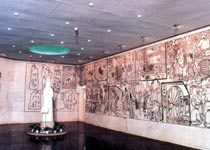Attration Category
Suzhou Weather

The entire museum design is dignified and elegant - yet unconventional - combining a sense of ancient civilization with modern style. The Suzhou Silk Museum is divided into several parts: the Introductory Hall, the Ancient Exhibit Hall, the Silkworm-Rearing Room, the Silk Weaving Workshop, the Neoteric (1840 - 1919) Exhibit Hall, and the Modern (1919 - 1949) Exhibit Hall. There are also retail stores for purchasing silk.
The dominant color of Suzhou Silk Museum is white, which represents the purity of silk. Strolling through the gate of the museum, you can see a long and elegant wall running from south to north, crossing an east-to-west road symbolizing the Silk Road. The wall curves at the entrance, symbolizing the softness and elegance of the silk. In front of the wall, there are three tall sculptures made of white marble. The first shows a girl picking mulberry leaves (the silkworm's favorite food); the second, a girl washing the raw silk fabric; the third, a girl weaving. The three sculptures give the whole museum a dynamic beauty, imparting a sense of freshness to the style of both the construction and the decoration. A tower-shaped roof on the main building of the museum reminds people of the exotic flavor of the Silk Road.
Entering the Introductory Hall, the glorious history of silk catches your eyes first. In the center of the hall there is a stone wall on which four Chinese characters are carved. The characters are modeled on the inscriptions on bones or tortoise shells of the Shang Dynasty (16th -11th century BC). These four characters give a summary of all the exhibits of the museum. On the left side of the hall, a huge stone fresco vividly describes the evolution and scientific achievements of silk development in ancient China. A statue of a beautiful woman stands close to this fresco. She is dressed in the ancient costume with a cocoon held in both of her hands. The expression in her eyes seems to tell people that she is thinking deeply. This is the legendary woman in Chinese history and fairytales: Lei Zu, wife of Huangdi , the first person who raised silkworms. On the right side of the wall, a group of large and vivid sculptures depict a camel caravan crossing a vast desert. It is reminiscent of the Silk Road, the road on which the earliest Eastern and Western exchanges took place. Looking up, countless milk-white transparent lights in cocoon-shape remind you of the world of ancient silkworm cultivation.
In the Ancient Exhibit Hall, the exhibits present the long history of silk in the form of precious silk relics, models and pictures from its origin in the late period of the Neolithic Age to its production in the Ming and Qing dynasties. It is not exaggerating to say that the exhibits in this hall are a concentrated history of Chinese silk in ancient times.


